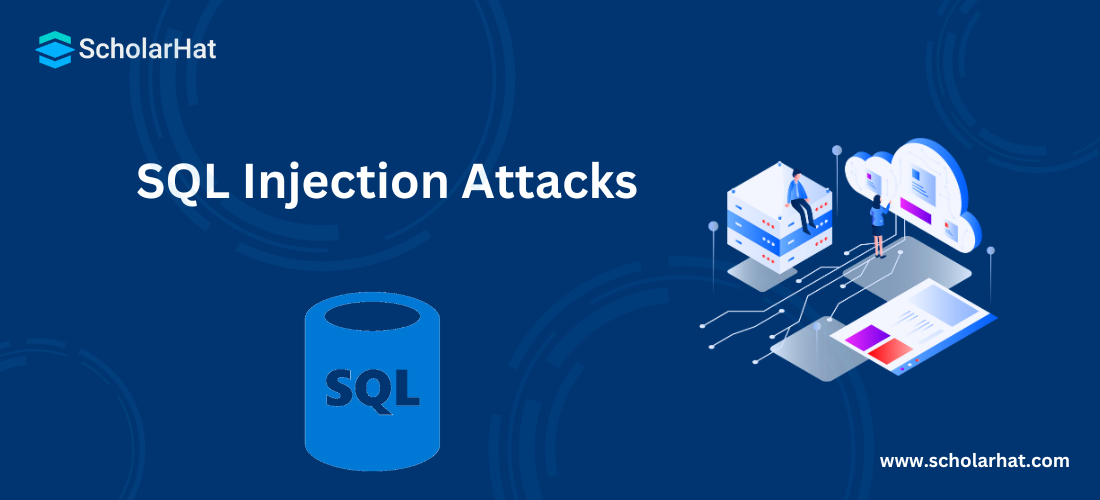18
AprSQL Injection Attacks: How to be Aware?
SQL Injection Attacks
A SQL Injection attack is a method used by hackers to steal sensitive data from an organization's database. Hackers use vulnerabilities in application layer coding to introduce SQL commands into user input fields, allowing them to directly query the database and compromise its security. Understanding and preventing such threats is essential nowadays.
In this SQL Server tutorial, we have explored SQL injection attacks and their prevention tips. So stick with this article and be aware..!
What Are SQL Queries?
SQL (Structured Query Language) is a powerful language used to manage and manipulate relational databases. SQL queries allow users to interact with the database by retrieving, inserting, updating, or deleting data.
SELECT * FROM Users WHERE Username='admin';This query retrieves the details of a user with the username 'admin'. However, SQL queries can be vulnerable to SQL injection attacks if not properly handled.
Read More - Top 50 SQL Interview Questions For Freshers
What is an SQL injection attack?
A SQL injection attack exploits a vulnerability in a web application, allowing hackers to change the queries being conducted on the underlying database. Web applications that immediately execute user inputs as queries are vulnerable to SQL injections. This enables attackers to run malicious queries, sometimes known as malicious payloads, on database servers.
Impact of a Successful SQL Injection Attack
A successful SQL injection attack can allow attackers to:
- Gain unauthorized access to sensitive data.
- Bypass authentication and impersonate users.
- Manipulate or delete data.
- Escalate privileges and take control of the server.
SQL Injection: A Simple Example
To explain this issue, Let's create a table "tbluser" to describe the SQL Injection Attack.
Create table tbluser
(
userName varchar(50) primary key,
userpwd varchar(50),
address varchar(100)
)
insert into tbluser(userName,userpwd,address)values('mohan@gmail.com','123456','Delhi');
insert into tbluser(userName,userpwd,address)values('shailendra@gmail.com','123456','Noida');
insert into tbluser(userName,userpwd,address)values('jitendra@gmail.com','123456','Gurgaon');
insert into tbluser(userName,userpwd,address)values('bipul@gmail.com','123456','Delhi');
select * from tbluser Now let’s look at the following query string in Asp.net. In this we are passing username from TextBox "txtUserID" and userpwd from TextBox "txtpwd" to check user credentials.
"SELECT * FROM tbluser WHERE userName = '"+ txtUserID.text +"' and userpwd = '"+ txtPwd.text +"'"; Now hacker will pass the following input to TextBoxes to inject sql attack. What will happen when the below data goes as input?
"SELECT * FROM tbluser WHERE userName = ';Drop table tblusers --' and userpwd = '123'"; The semicolon; in the above statement will terminate the current sql. So, "SELECT * FROM tbluser WHERE UserID = ''" will become a separate statement, and after Semi Colon; it will start a new sql statement "Drop table tblusers" that will drop our table tbluser. Hence your user details table has been dropped and your database will be unmanaged.
How Does a SQL Injection Attack Work?
SQL injection attacks work by injecting malicious code into input fields, like login forms or search boxes.
SELECT * FROM Users WHERE Username = 'inputUsername' AND Password = 'inputPassword';An attacker could input:
Username: admin' --This modifies the query to bypass authentication:
SELECT * FROM Users WHERE Username = 'admin' --';Real-Life SQL Injection Attack Examples
Examples of major SQL injection attacks include:
- Heartland Payment Systems (2008): Over 130 million credit card numbers were stolen.
- Sony Pictures (2011): Confidential data was leaked, including customer information.
- TalkTalk (2015): A data breach exposed sensitive information of over 150,000 customers.
Breaches Enabled by SQL Injection
SQL injection attacks have led to significant data breaches and financial loss for several organizations. Proper coding practices are essential to prevent these breaches.
Notable SQL Injection Vulnerabilities
- Unsanitized user inputs
- Dynamic SQL queries without parameterization
- Exposed error messages that reveal database structure
Types of SQL Injection Attacks
- In-band SQL Injection (Classic SQLi): Using the same channel for injection and data retrieval.
- Inferential SQL Injection (Blind SQLi): Gathering information by analyzing server responses without seeing the data directly.
- Out-of-Band SQL Injection: Using different channels to retrieve data.
SQL Injection Code Examples
Example 1: Using SQLi to Authenticate as Administrator
Username: ' OR 1=1 --This input bypasses the password check by always evaluating the condition as true.
Example 2: Using SQLi to Access Sensitive Data
Username: ' UNION SELECT CreditCardNumber, ExpiryDate FROM CreditCards --This input extracts credit card details from another table using the UNION keyword.
Example 3: Injecting Malicious Statements into Form Fields
Username: '; DROP TABLE Users --This query deletes the entire Users table.
SQL Injection Prevention
- Use Parameterized Queries/Prepared Statements: Separate user input from the SQL query.
- Use Stored Procedures: Avoid dynamically building SQL queries.
- Validate User Input: Always validate and sanitize input data.
- Apply Least Privilege Principle: Ensure application accounts have minimal database access.
- Hide Error Messages: Don’t expose detailed error messages to users.
- Deploy Web Application Firewalls (WAFs): Block SQLi attacks in real time.
Solution for SQL Injection Attack
In C# or VB.Net during building a SQL Statement, use the SqlParameter to define the Parameter Name, type, and value instead of making a straight command like above.
In Asp.Net query specify that CommandType as Text or Stored Procedure.
When we use Parameters Collection, we should use parameters the type and size will also be mentioned.
If we use stored procedure, instead of directly building by using Exec command, use sp_executesql command.
Another way to stop SQL injection attacks is to filter the user input for SQL characters. Use the REPLACE function to replace any apostrophe (single quotation mark to SQL) with an additional apostrophe. Within a SQL string, two consecutive single quotation marks are treated as an instance of the apostrophe character within the string.
Read More
Conclusion
In this article, I tried to explain the SQL Injection attack. I hope after reading this article will be aware of the SQL Injection attack. I would like to have feedback from my blog readers. Please post your feedback, questions, or comments about this article. Also, consider our SQL Server Certification Course for a better understanding of other SQL concepts.
FAQs
Take our Sqlserver skill challenge to evaluate yourself!

In less than 5 minutes, with our skill challenge, you can identify your knowledge gaps and strengths in a given skill.








